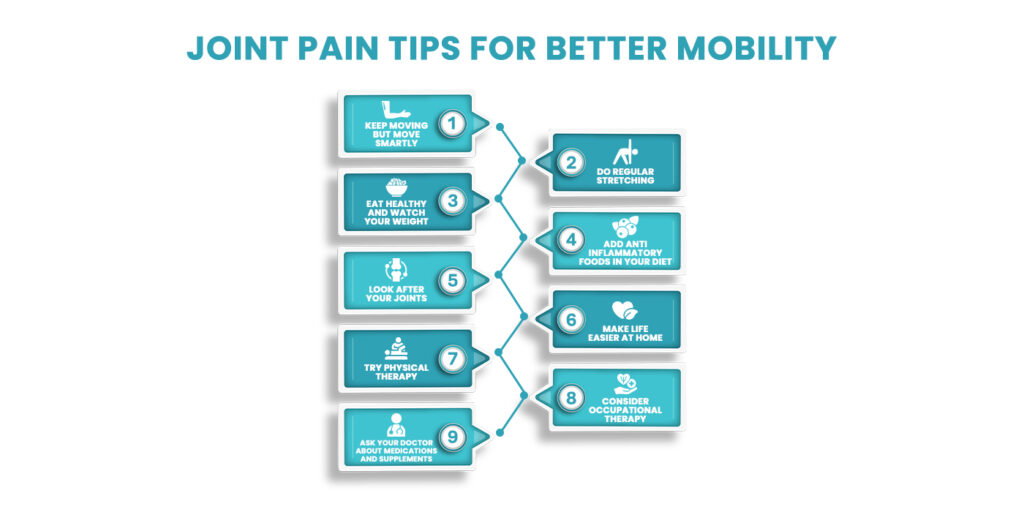Joint pain can come on slowly or hit you all at once— but no matter how it starts it can really throw off your daily routine. It can seriously impact your ability to move and enjoy life. Simple tasks like climbing stairs, opening jars, and even getting dressed can become painful and frustrating.
But the good news? With a few smart habits and the right support, you can still live a full and active life. Let’s have a deeper look on living with joint pain and some practical tips that can help improve your mobility.

1.Keep Moving — But Move Smartly:
It is natural to avoid movement when your joints are hurting. But staying active in the right way is actually good for your aching joints.
Gentle movement can help ease stiffness in your joints and keep them flexible, strengthen your muscles, and even boost your mood.
The key is to not push too hard and avoid the exercises that make your pain worse. Low-impact activities like walking, swimming, gentle stretching, and yoga are some great options.
Try to avoid activities that involve high impact or repetitive movements, like running, jumping, or high-impact workouts. Even doing the same motions over and over like swinging a tennis racket can aggravate your joint pain.
And before starting anything new, It’s always better to check in with your doctor. They’ll help you find what’s safe and actually useful for your body.
2.Do Regular Stretching:
A few gentle stretches everyday can go a long way toward loosening up stiff joints. Stretching can also help maintain range of motion and flexibility, which is important for joint health. You don’t need to spend hours, just a few minutes each day can help you stay loose and mobile.
Focus on the big muscle groups that support your joints like your hips, hamstrings, shoulders, and back.
Mornings can be rough as it’s the time when joints are usually stiffest, so it’s a good time to do some stretching.
If you’re not sure where to start, your healthcare provider can walk you through the best moves for your specific needs.
3.Eat Healthy and Watch Your Weight:
Eating healthy is important especially if you’re dealing with joint pain. A balanced diet helps you stay strong, maintain a healthy weight, and reduce unnecessary pressure on your joints.
Try to eat a mix of food from all major food groups, like fruits, vegetables, grains, proteins, and dairy.
If you’re overweight, shedding a few pounds can ease the load on your knees, hips, and feet. This will help reduce pain and improve your mobility.
4.Add Anti-Inflammatory Foods In Your Diet:
Your diet makes a big difference in how your joints feel. A diet rich in anti-inflammatory foods may help reduce pain and stiffness in your joints.
Try adding these in your diet:
- Fatty fish (like salmon and sardines)
- Leafy green vegetables like spinach and kale
- Fruits like berries, cherries, and oranges
- Nuts and seeds
- Whole grains
- Spices like turmeric and ginger
5.Look After Your Joints:
Protecting your joints now can help you avoid further damage later on. A few simple changes can make daily activities more joint-friendly. Such as:
- Try to use stronger joints — like your shoulder instead of your hand — to reduce strain, e.g take the pressure on your shoulder rather than on your hand, to open a heavy door
- Carry objects with both hands or use bags that evenly distribute weight
- Avoid tight grips by using padded or ergonomic handles
- Take regular breaks to avoid staying in one position for too long
- Try to keep a good body posture, it can take surprising amount of pressure off your joints
These habits help preserve joint health and reduce discomfort throughout the day.
6.Make Life Easier at Home:
Everyday tasks like cooking and cleaning can feel a lot harder when your joints are hurting But even a few small changes around the house can go a long way and help you move around more safely and comfortably:
- Keep everyday items somewhere easy to reach so you don’t have to bend or stretch to get them
- Install handrails in spots where you need extra support like bathroom or stairs
- Try using long-handled tools or electric gadgets in the kitchen to cut down on strain
- Add lever handles to taps to make them easier to turn
7.Try Physical Therapy:
A physical therapist can assess your movement, identify your weaknesses, and teach you specific exercises that target your needs. They can also help you to improve your posture and movement patterns to avoid future strains.
Think of it as a personalised coaching for your joints — it’s often one of the most effective ways to build long-term strength and mobility.
8.Consider Occupational Therapy:
If your joint pain significantly affects your ability to manage things at home, an occupational therapist can be helpful for you. They can suggest tools, home modifications, or techniques to help you with your daily tasks like cooking, cleaning, and dressing.
9.Ask Your Doctor About Medications and Supplements:
If your pain is interfering with your life, don’t be afraid to ask your doctor about treatment options for joint pain. Over-the-counter pain relievers, anti-inflammatory medicines, or supplements like glucosamine may help some people. It’s best to check in with your doctor before starting any new medication or supplement, especially if you’re already taking any medications.
Final Thoughts:
Living with joint pain can be frustrating, but there are practical steps you can take to reduce discomfort and improve your mobility. Think of it as a journey, not a quick fix. Take it one day at a time and keep moving forward with patience and a positive mindset!








